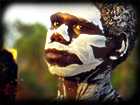

A
HISTORY OF THE YOLNGU
Yolngu culture in north-east Arnhem Land - a heartland of Aboriginal culture and land rights - is among the oldest living cultures on earth, stretching back over 40,000 years. It is only since 1935 that the Yolngu people have had sustained contact with the Balanda (Europeans), firstly through Methodist missions, then through contact with service personnel during World War Two and, more recently, with the imposition of multi-national mines on their tribal lands.
Yolngu people speak a dozen dialects of a language group known as Yolngu matha. English is very much a second (or thirteenth) language. Since the 1960's Yolngu leaders have been conspicuous in the struggle for Aboriginal land rights. In 1963, provoked by a unilateral government decision to excise a part of their land for a bauxite mine, Yolngu people at Yirrkala in north east Arnhem land sent to the House of Representatives a petition on bark (the traditional medium for visual art representation). The bark petition attracted national and international attention and now hangs in the national parliament as a testament to the Yolngu role in the birth of the land rights movement.
Yirrkala
in the year 2001 rests firmly on the foundations established by the law
and the achievements of previous generations of elders. There are 25 homeland
centres in the hinterland which were established during the seventies
as a reaction to the imposition of the mine on the land around Yirrkala.
People move between Yirrkala and their ancestral homelands depending on
the ceremonial calendar, seasonal considerations and secular
ones. All of these homelands are without mains power and all weather access.
Some of them have up to a hundred people living up to 200 km from Yirrkala.
One of the main sources of income for these bush people is the sale of
sacred art made from natural media. This art has gained acceptance in
the mainstream world as award-winning fine art from an artistic
tradition independent of Western art. It has been used in the advancement
of Yolngu political and social goals (the Yirrkala Church Panels, the
Bark Petition, the Barunga Statement, the Saltwater Collection). The main
life of these sacred designs persists in formal ceremonial contexts.

see
the Buku Larrngay Community Centre website
GLOSSARY
Note: (The Aboriginal words featured are from the Gumatj language)
Balanda: Person of non-Aboriginal origin. HOW DO I PRONOUNCE IT?
Baru: Refers to the crocodile and is represented by a diamond pattern. 'Baru' is the venerated totem of the Gumatj people. HOW DO I PRONOUNCE IT?
Bilma: Ironwood clap sticks. HOW DO I PRONOUNCE IT?
Gapan: Comes from the soil and must be mixed with water to obtain the right consistency. Varies from community to community and has the ability to repel insects. In times of war a tribe would paint themselves with Gappan before confronting their enemy. Each tribe could be identified by the way in which they applied it. HOW DO I PRONOUNCE IT?
Galka: Bad spirit. Also refers to an evil person such as an assassin. HOW DO I PRONOUNCE IT?
Gumatj: One of the sixteen tribes that live in and around north-east Arnhem Land. HOW DO I PRONOUNCE IT?
Maralitja Man: A magic spirit guide. HOW DO I PRONOUNCE IT?
Naga: Ceremonial loin cloth worn by men. HOW DO I PRONOUNCE IT?
Rowu: A vine-like leaf, found along coastal areas with healing properties. Once heated, it can be applied to flesh burns. HOW DO I PRONOUNCE IT?
Songlines: The belief of the Aboriginal people is that when you sing, you sing about whatever is in the land or on the land, including the trees and animals. It's like navigating your way through the land by singing about it. If you know the words to a particular song, that song can, in turn, connect to another song that will help you find your way. Each clan has their own songs that connect from clan to clan and so forth.
Totem: Every tribe or clan group has their own ancestral totem, generally represented by an animal and greatly revered.
Yidaki: Didgeridu or hollow log. HOW DO I PRONOUNCE IT?
Yolngu: Essentially means Aboriginal human being and in particular refers to people who belong to the 16 or so clans that live in and around north-east Arnhem Land. HOW DO I PRONOUNCE IT?